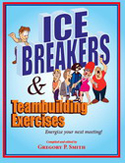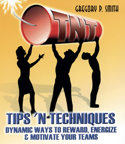Employee of the Month Programs Don’t Work
Here is a question sent to me:
I attended your session in Philadelphia called, “The Care and Feeding of
Staff: Energize, Engage, and Motivate Your Work Force.” It The timing
was just right. Our firm is beginning an ‘Employee of the Month Award’.
We hope this will be a morale booster.
I wanted to know if you could give me any pointers. Can you suggest
some criteria for such an award? Also, should the employees decide what
criteria will be used?
Our law firm is relatively small. We have five attorneys with a support
staff of ten. Several employees have over fifteen years service with the
company. Any suggestions would be greatly appreciated.
Thank You, Richard
My reply:
I applaud your efforts in wanting to create a reward and recognition
system, but being a small firm makes an EOM program that much more
challenging.
Most of the Employee of the Month programs I have seen rarely work as
intended. The results fall short, and in some cases the program can do
more harm than good. Why?
Fairness is the main problem. Any program that selects only one winner
is bound and determined to make others feel like losers. Also, employees
must be nominated to be considered. But what happens to people who
deserve recognition, but work for managers who do not take the time to
nominate anyone? What happens to people who maintain nontraditional work
schedules such as those who telecommute or work remotely? Honoring one
person a month also defeats teamwork. Instead of only recognizing one
employee, many of my clients recognize the “Team of the Month.”
The goal of any reward and recognition program is to encourage,
recognize, and show appreciation to those who work in your office.
However, the most important reason is to align behaviors with the goals
making your organization successful. Most organizations miss this
important point.
Since you are a small firm, your candidate pool is very limited. You will
fall in to the trap of giving the EOM only to a few people–your top
performers. Or on the other hand, you may be forced to rotate the EOM
award from person to person, whether they deserve it or not, just to meet
the requirement each month. Is this your intention?
One organization we worked with was unhappy with the results of their EOM
program. Every month managers nominated one person for selection. Part
of the difficulty was that person had to compete against people working
in eight different locations. A committee of eight senior managers, one
from each building, selected only one winner. The winner was awarded a
savings bond.
There are several weaknesses with this program. First, the winners felt
uncomfortable winning the award. They realized there were coworkers just
as deserving as they. Second, there were others in the organization who
were never considered or nominated. They felt “ignored” and not
appreciated. Then there were those who felt the managers were playing
favorites–you had to “brown nose” your boss in order to win. The
program generated more negative feelings than good. Something had to
change.
The organization followed our recommendation to allow the employees
themselves the opportunity to redesign a better system. We convened a
problem-solving team consisting of one volunteer from each location. At
the first meeting, we outlined the options they could consider. Then we
let them go to work.
An hour or two later they came up with a brand new program. They decided
to create a peer selection process. They did not want management to make
the selection. Each building would run a separate Employee of the Month
program. Then they decided to collect money to buy a plaque for each
building to display winners’ names. Finally, the staff would take the
winner out for breakfast each month and provide them a reserved parking
space near the front door of their office.
Greg Smith helps create high performance organizations that attract,
keep, and motivate their workforce. As President of Chart Your Course
International he has designed and implemented professional development
programs for hundreds of organizations globally. As a business growth
consultant, he has helped business owners reduce turnover, increase
sales, deliver better customer service, and reach long-term prosperity.
Greg is published in hundreds of trade publications. He is also the
author of Here Today, Here Tomorrow: Transforming Your Workforce from
High Turnover to High Retention, the New Leader, and several other books.
For more information, visit http://www.chartcourse.com or call (800)
821-2487 or (770) 860-9464.
We show businesses how to hire, retain and engage the workforce.
770-860-9464
No related posts.















